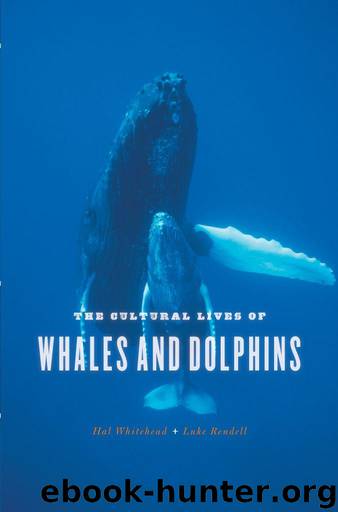The Cultural Lives of Whales and Dolphins by Hal Whitehead & Luke Rendell

Author:Hal Whitehead & Luke Rendell [Whitehead, Hal]
Language: eng
Format: epub
ISBN: 9780226187426
Publisher: University of Chicago Press
Published: 2014-12-03T13:00:00+00:00
9 | HOW THE WHALES GOT CULTURE
We hope we have succeeded in convincing you that quite a lot of whale and dolphin behavior is acquired by social learning, is shared by groups, and therefore is culture—precisely how much is uncertain. In the previous chapter we outlined a minimum pool—definite culture—and a fuzzy area around it—likely culture. As science has so far only managed to get its hooks into a few areas of behavior for a few cetacean species, we are certainly missing much of the cultures of whales and dolphins. That huge slab of unknown whale culture is tantalizing, and it drives our own research. Where does it reach? How does it link: from cultural behavior to cultural behavior; from cultural animal to cultural animal; from cultural species to cultural species? And how does culture affect sociality, ecology, conservation and evolution? How can we find our way into all this?
There is also much uncertainty about the extent of culture elsewhere outside humans. We must be missing much of the culture of chimpanzees, crows, and elephants. There is fish culture and rat culture that we don’t know about. However, the extent of this uncertainty is generally much less than with whales. Most terrestrial mammals and birds are visible and live in an environment similar to our human environment, one that we feel that we innately understand pretty well. Many of these animals can be studied in controlled, captive conditions. So we get a better feel for how their lives work. With the exception of the whales and dolphins, and perhaps elephants (see chap. 12), science as a whole has achieved what might be called a basic understanding of the extent of culture among animals.1 Culture seems remarkably restricted. While there appears to be a cultural contribution toward some behavior in many social species, such as numerous songbirds, coral-reef fish and even some insects, there are fewer for whom culture seems important in a number of facets of life and for whom their offspring would simply not be viable without significant cultural inputs at crucial times during their development.
This becomes something of a puzzle. If culture is useful, then why don’t more species use it more often? And if it is not useful, why do a few species use it a lot? In the words of Peter Richerson and Robert Boyd: “The exceptional nature of the human species deepens the puzzle—if culture is so great, why don’t lots of other species have it? One of Charles Darwin’s rare blunders was his conviction that the ability to imitate was a common animal adaptation.”2 From this perspective, it is the rarity of imitation that explains the rarity of culture, a consequence of imitation being a central plank of some definitions of culture. However, we have hopefully made it clear by now that we do not think imitation is the only way social learning can lead to persistent complexes of behavior that we might usefully identify as cultures. For us then, the rarity of culture
Download
This site does not store any files on its server. We only index and link to content provided by other sites. Please contact the content providers to delete copyright contents if any and email us, we'll remove relevant links or contents immediately.
Sapiens: A Brief History of Humankind by Yuval Noah Harari(14166)
The Tidewater Tales by John Barth(12576)
Mastermind: How to Think Like Sherlock Holmes by Maria Konnikova(7164)
Do No Harm Stories of Life, Death and Brain Surgery by Henry Marsh(6840)
The Thirst by Nesbo Jo(6763)
Why We Sleep: Unlocking the Power of Sleep and Dreams by Matthew Walker(6557)
Life 3.0: Being Human in the Age of Artificial Intelligence by Tegmark Max(5405)
Sapiens by Yuval Noah Harari(5264)
The Longevity Diet by Valter Longo(4994)
The Body: A Guide for Occupants by Bill Bryson(4887)
The Rules Do Not Apply by Ariel Levy(4789)
The Immortal Life of Henrietta Lacks by Rebecca Skloot(4447)
Animal Frequency by Melissa Alvarez(4365)
Why We Sleep by Matthew Walker(4317)
The Hacking of the American Mind by Robert H. Lustig(4265)
Yoga Anatomy by Kaminoff Leslie(4248)
All Creatures Great and Small by James Herriot(4190)
Double Down (Diary of a Wimpy Kid Book 11) by Jeff Kinney(4145)
Barron's AP Biology by Goldberg M.S. Deborah T(4063)
